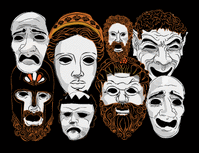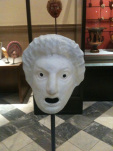Historia Antiqua - Frescos, Wall Paintings, Theater Masks; Pompeii
Pigments Through the Ages: Antiquity
Have you ever wondered where ancient artists acquired their paint? The Minoans get the credit for inventing the fresco- paintings on a lime plaster surface. The Egyptians weren’t far behind, and they mixed their ground pigments with something like animal glue so they’d stick to the plaster. The Greeks and Romans used a wax resin or eggs as a binder for pigments, which has lasted on tomb walls for many centuries. Egyptian colors were symbolic and strictly regulated. The Greeks invented lead white and red lead. The Romans get credit for creating the vermilion pigment mined in Spain.
Topic: Pigments, Color in art Language: English Lexile: 1180 http://www.webexhibits.org
Resurrecting Pompeii
It happened at daybreak. People tried to escape the city amidst raining pumice and a sulfurous sky. Some carried amulets, jewelry, and coins. Thousands died in Pompeii as a cloud of scorching gases stole life from this vibrant city. The natural disaster left the city buried and forgotten from 79 A.D. until the 18th century. A 19th century Italian archeologist has the idea of pouring plaster into cavities in the hardened ash. The result was lifelike images of the final moments and poses of the people of Pompeii. Learn about this ancient prosperous city with running water and lavish homes.
Topic: Pompeii (Extinct city) Language: English Magazine http://www.smithsonianmag.com
Ancient Art
Explore portraits carved in alabaster and stone from Egypt and Assyria. A small statue of a bearded man was carved in limestone more than 4,500 years ago in Mesopotamia. See warriors and mythological scenes depicted in Greek pottery. Roman mosaics also captured mythological scenes, along with the hunting of dangerous game. Floor mosaics in Rome echoed the role and patterns of oriental carpets. A bronze bust of a Roman woman shows the elaborate detail given to the hair. She seems contemplative, while the head of a Roman man carved in black basalt has a furrowed brow.
Topic: Roman art, Greek art Language: English Lexile: 1930 Image collection http://www.worcesterart.org
The Art of Ancient Greek Theater
Pottery, sculptures, and even a papyrus fragment provide clues about the history of Greek theater. From elaborate costumes to masks, Greek drama is often portrayed in the visual arts. Choral dances performed in honor of Dionysos evolved into dramatic tragedies and comedies. The great playwrights of ancient Greece competed at the Great Dionysia, a festival celebrating the cult of Dionysos. The Getty Museum performs a classical tragedy or comedy each fall in an outdoor theater designed like the ones in ancient Greece. Actors hold masks, a playwright is surrounded by the cast, and vases portray the stories of Greek tragedies.
Topic: Classical Greek drama, Dionysia Language: English Lexile: 1590 http://www.getty.edu
City Dionysia - Masks, Costumes & Props

Costumes and Masks; Greek Theatre

- EResources
- Ebooks
- Contests and Opportunities
- Faculty Resources
- Library Good Reads
- GradPoint (opens in new window)
- LibGuides
- NHS Library Seminars (opens in new window)
-
Historical Links
- Immigrant Groups in the West
- Immigrant Groups in the West Making the Connections
- Immigration Symbols
- Immigration West
- Industrial Revolution Resources List
- Industrialists
- Korean War
- Legacy of Jim Crow
- The 60's
- Women and the Industrial Revolution
- Working Women and the Industrial Revolution
- Working Women During the Industrial Revolution
- Against Slavery
- Immigration
- Louis Braille An Exceptional Man
- MLA and APA Style Guides
- Norwood High School Home
- Quick reference
- Research & Instruction
- Summer Work
- Textbooks
This site provides information using PDF, visit this link to download the Adobe Acrobat Reader DC software.
